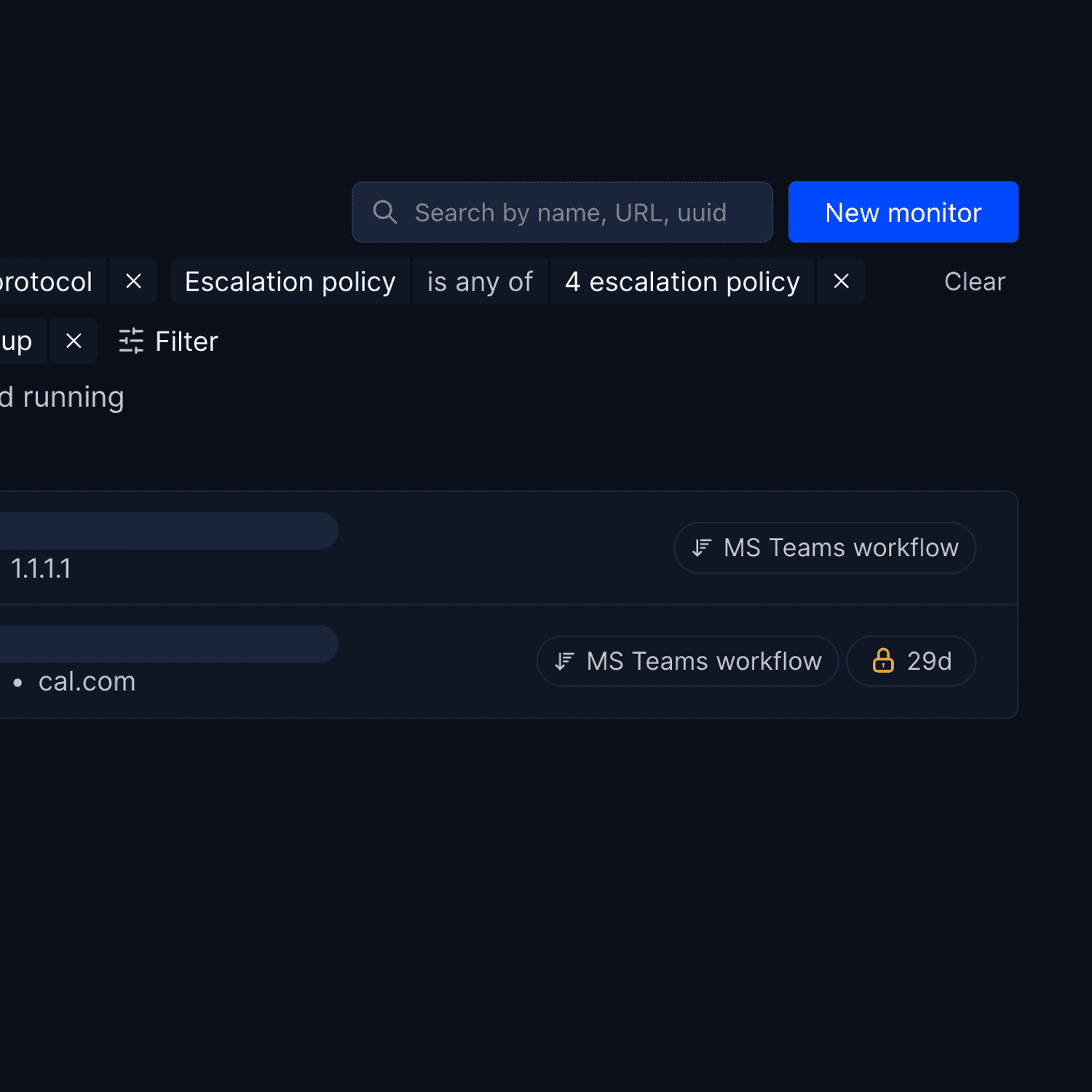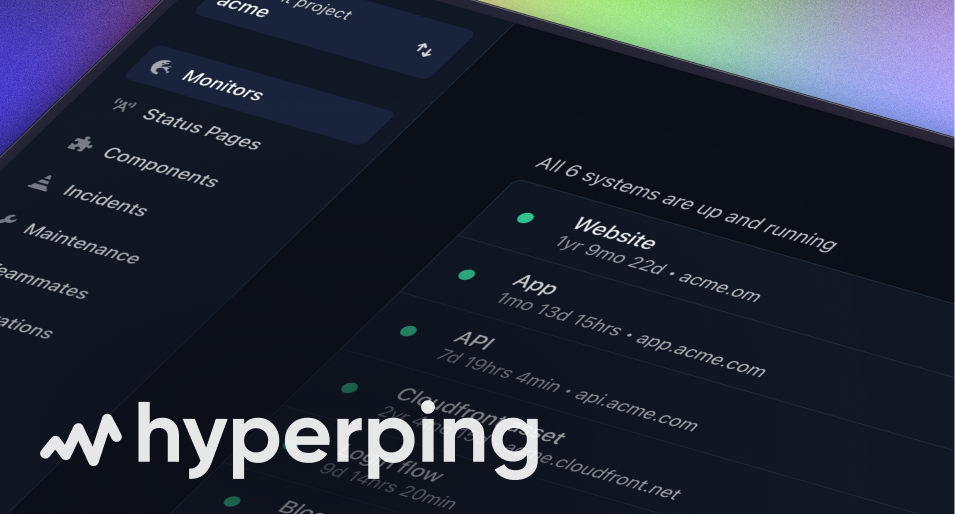Are you looking for a reliable status page solution to keep your users informed? Wondering what alternatives are available to help you communicate system status effectively?
While Statuspage.io used to be everyone's default choice, today's DevOps and SRE teams have a hard time justifying this choice.
And there are a lot of new tools popping up every year.
For this guide, we analyzed 25 tools and we'll explore the best status page software available today.
We'll break down their key features, pricing, and ideal use cases to help you find the perfect fit for your team.
Whether you're looking for better value, more customization options, or enterprise-grade features, you'll find options that match your specific needs.
Common problems with popular status page tools
Nowadays, customers look for status pages. So having a subpar page is a red flag for them. And popular solutions have drawbacks:
1. High costs for basic features
Many established platforms lock essential features like custom branding and private pages behind expensive premium tiers. This forces small teams to either overpay or settle for a limited free plan that doesn't meet their needs.
2. Complex setup and maintenance
Self-hosted solutions like Cachet and Statping require significant technical expertise to set up and maintain. Teams need to handle server configuration, security patches, and updates themselves, taking valuable time away from core development work.
3. Limited integration options
Some tools like Sorry App and StatusCast offer only basic integrations with popular services. This creates friction when trying to connect status pages with existing monitoring tools, notification systems, and team collaboration platforms.
4. Poor performance during high traffic
Traditional status page platforms can struggle during major incidents when traffic spikes. This is particularly problematic since status pages need to be most reliable exactly when systems are down and users are actively checking for updates.
5. Inflexible customization
Many solutions provide limited customization options, making it difficult to match your brand identity or create different page layouts for various audiences.
6. Unreliable real-time updates
Some platforms have delayed synchronization between monitoring alerts and status page updates. This lag in communication can lead to confused customers and increased support queries during incidents.
Summary: Our 5 top picks for status page tools
While dedicated status page solutions exist, most uptime monitoring software nowadays have status page capabilities as good as the dedicated solutions.
That's why most of our top picks are also monitoring tools.
| Name | Why we picked it | Free version? | Pricing |
|---|---|---|---|
| Hyperping | Best overall value with built-in monitoring, 30-second checks, and unlimited pages. EU-based for GDPR compliance. | 1 basic status page | Unlimited full-featured public and private pages for $74/mo |
| Better Stack | Sleek design and extensive features and integrations. | 1 basic status page | $29/mo per additional user, lots of features as paid addons |
| Instatus | Clean, simple solution focused purely on status pages. | Unlimited basic status pages | $15/mo per page with custom domain, $45/mo per private page |
| Statuspage.io | Market leader with advanced customization through CSS/HTML/JS. | 1 basic status page | Starts at $29/mo, quickly scales to $99/mo |
| Uptime | Most comprehensive monitoring features with global check locations. | No | 2 full-featured pages included in $67/mo plan |
Open-source status page tool pick
In a lot of cases, open-source solutions will give you extra work so it's not worth it in our opinion. But if you want our pick, it would be Cachet as it is the most capable in that category.
Other open-source tools: Upptime, Statping, Uptime Kuma, CState, Kener, Statusfy (but not longer maintained).
What about the other status page tools?
We don't have time to write in depth about each tool but here's a summary about the alternatives we dismissed.
- Pricing too steep — Status.io, Sorry App, StatusGator, StatusDashboard
- Hidden pricing — StatusCast
- Status pages lack too many features — Incident.io, Uptime Robot, Upptime, Statping, CState, Pulsetic, Super Monitoring, OffAlerts, Pingdom
1. Hyperping
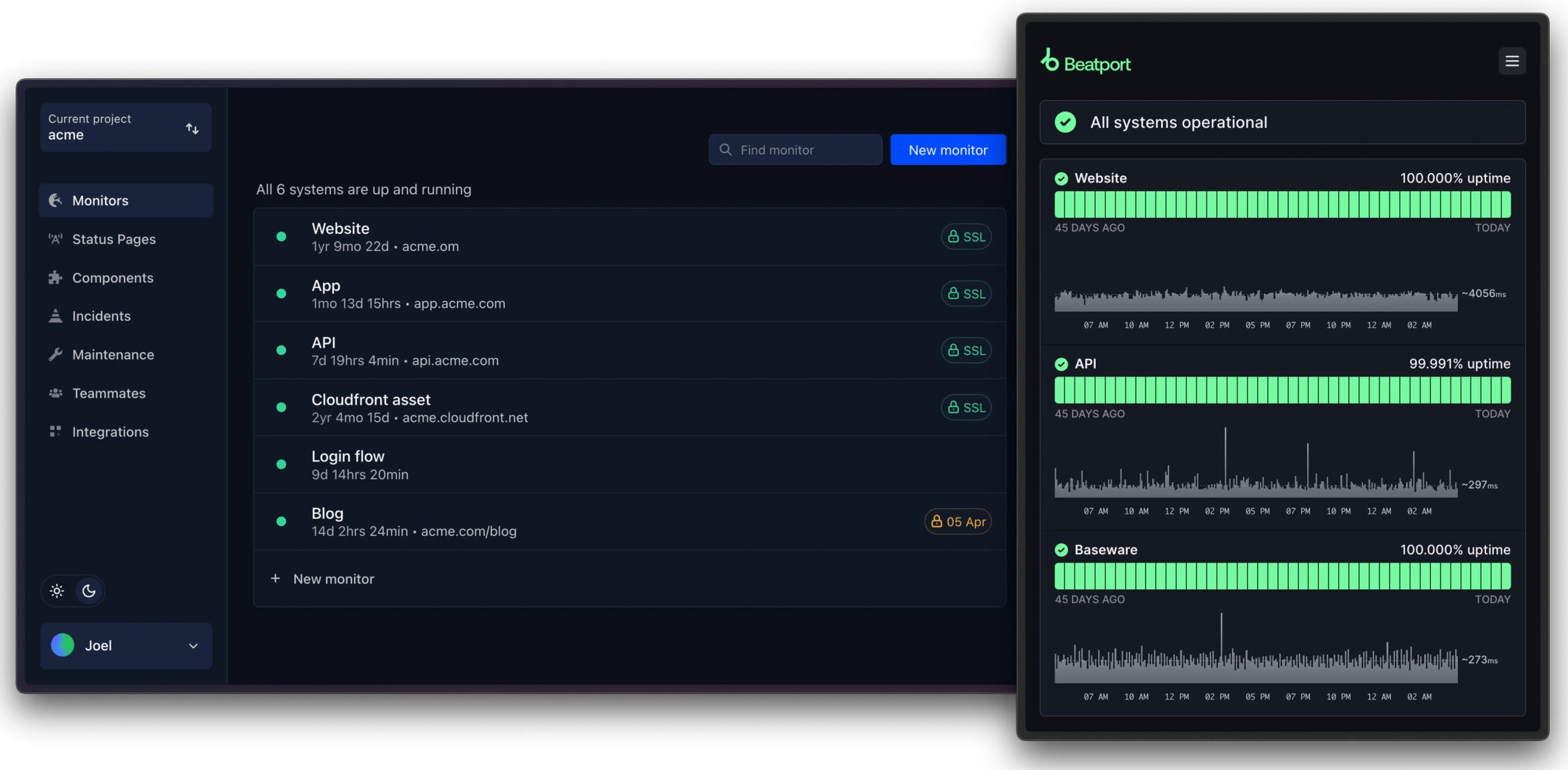
Hyperping is an all-in-one solution that provides beautiful and intuitive status pages with built-in monitoring with advanced tooling such as HTTP, ICMP or Cron job, that makes real-time updates flawless between your monitors and your status pages.
Main benefits
- Built-in uptime monitoring
- Static status pages for instant loading
- Publish incident updates
- Scheduled maintenance
- Integrations such as PagerDuty, Teams, Slack
- Works great for multi-tenancy
- Browse incident & uptime history in status pages
Pricing
- 1 free basic status page.
- $24/mo for 50 monitors, 2 users, 1 full-featured status page, and more.
- Unlimited private and public full-featured pages for $74/mo. Also includes 6 users, 100 monitors, and more.
Compare Hyperping with other uptime monitoring tools
2. Better Stack
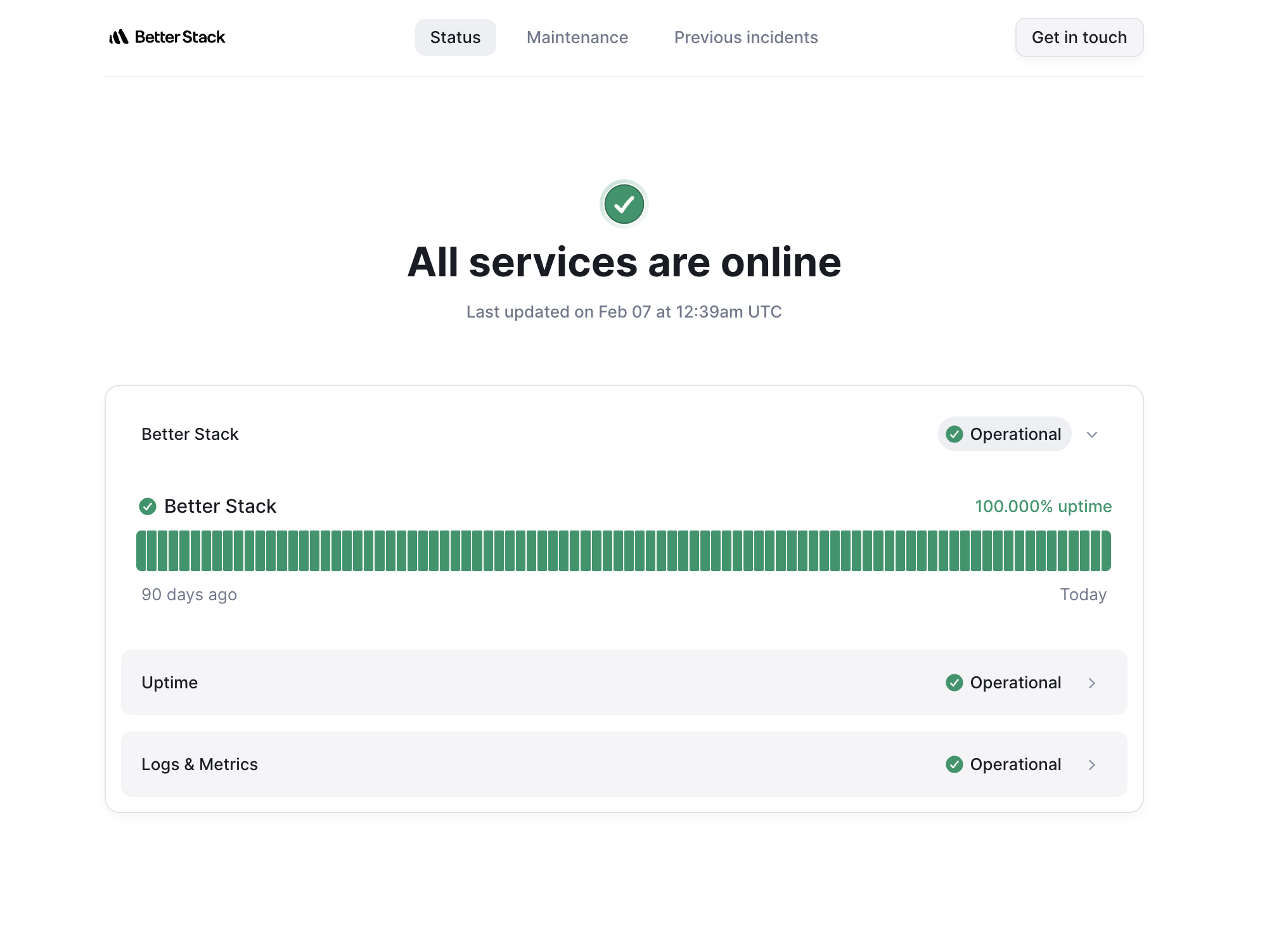
Better Stack combines uptime monitoring, log management, and status pages into a comprehensive platform. While it excels at providing detailed system insights and team collaboration features, its pricing structure can become expensive as teams grow.
Pros
- On-call scheduling
- Log management
- Advanced reporting
Cons
- Expensive & complex pricing
- Not in the EU anymore
Why choose Hyperping over Better Stack?
Simple pricing
Better Stack charges per user and with addons for each little thing. Hyperping doesn't. Instead you get 100 monitors, 10 synthetic monitors, unlimited status pages, and 5 teammates for $74 per month. For the same, Better Stack would cost more than $200 per month.
GDPR
Better Stack started as a EU company but since they've raised money, they're now a US company and don't have the same guarantees as us. Hyperping is a French company hosted in EU data centers by EU companies. If it's something important for you, look no further.
Better Stack has more features
Better Stack beats Hyperping when it comes to features. We strive to make the best product, but if you compare us with them on a feature basis, they have the advantage. We won't pretend otherwise.
3. Instatus
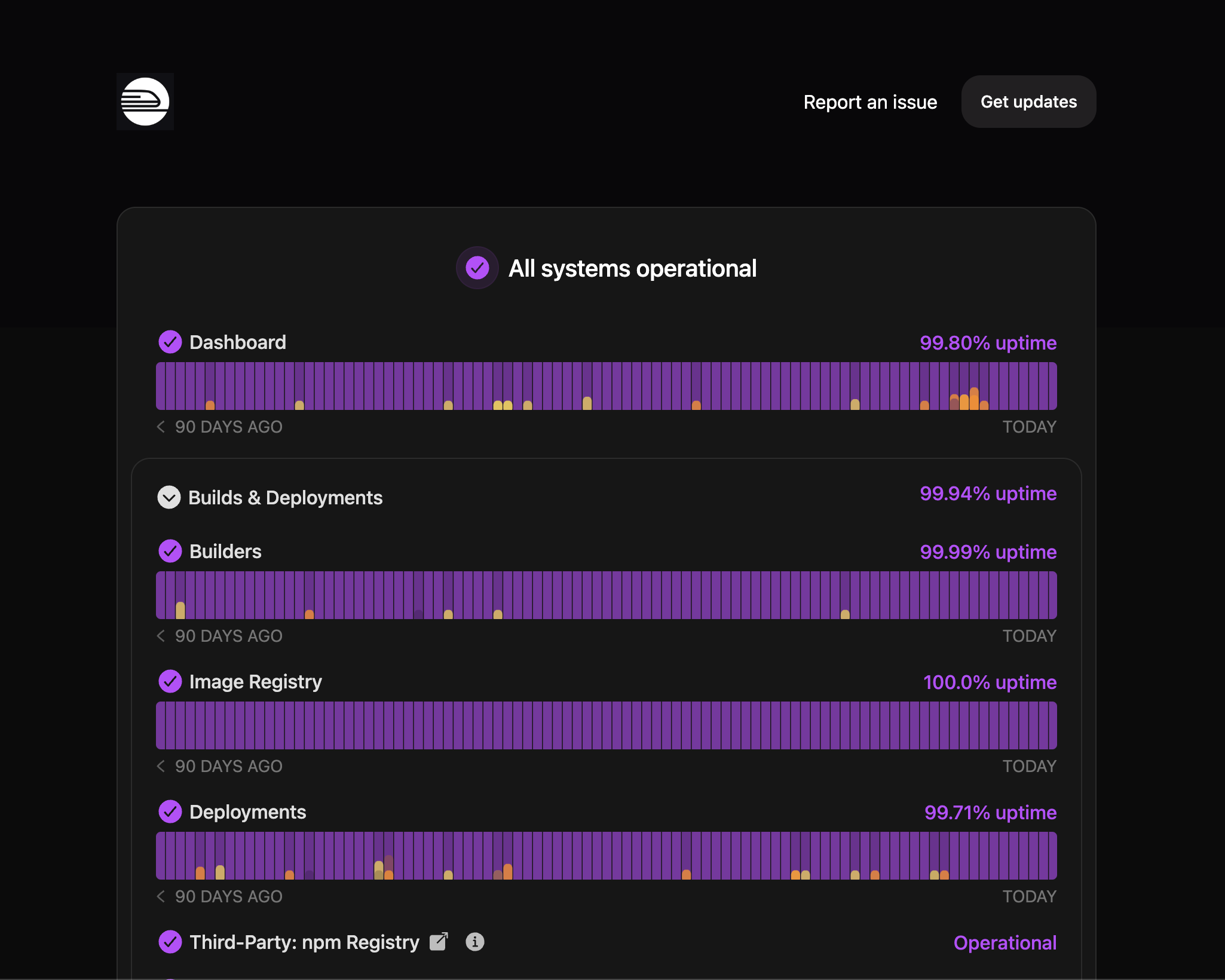
Instatus focuses on providing a well-designed status page solution with reasonable pricing for smaller teams. The platform offers essential features like customizable status pages, real-time notifications, and incident management capabilities.
Pros
- Free status pages with unlimited subscribers.
Cons
- Each page cost $15/month if you want a custom domain and private pages start at $45/month per page.
Why choose Hyperping over Instatus
All-in-one solution
While Instatus provides status pages, it lacks built-in monitoring capabilities. With Hyperping, you get uptime monitoring and status pages in one platform, making incident detection and communication seamless. You don't need to integrate third-party monitoring tools.
More cost-effective for multiple pages
Instatus charges per status page ($15/month for custom domains, $45/month for private pages). Hyperping includes unlimited public and private status pages with custom domains for $74/month, along with comprehensive monitoring features.
4. Statuspage.io
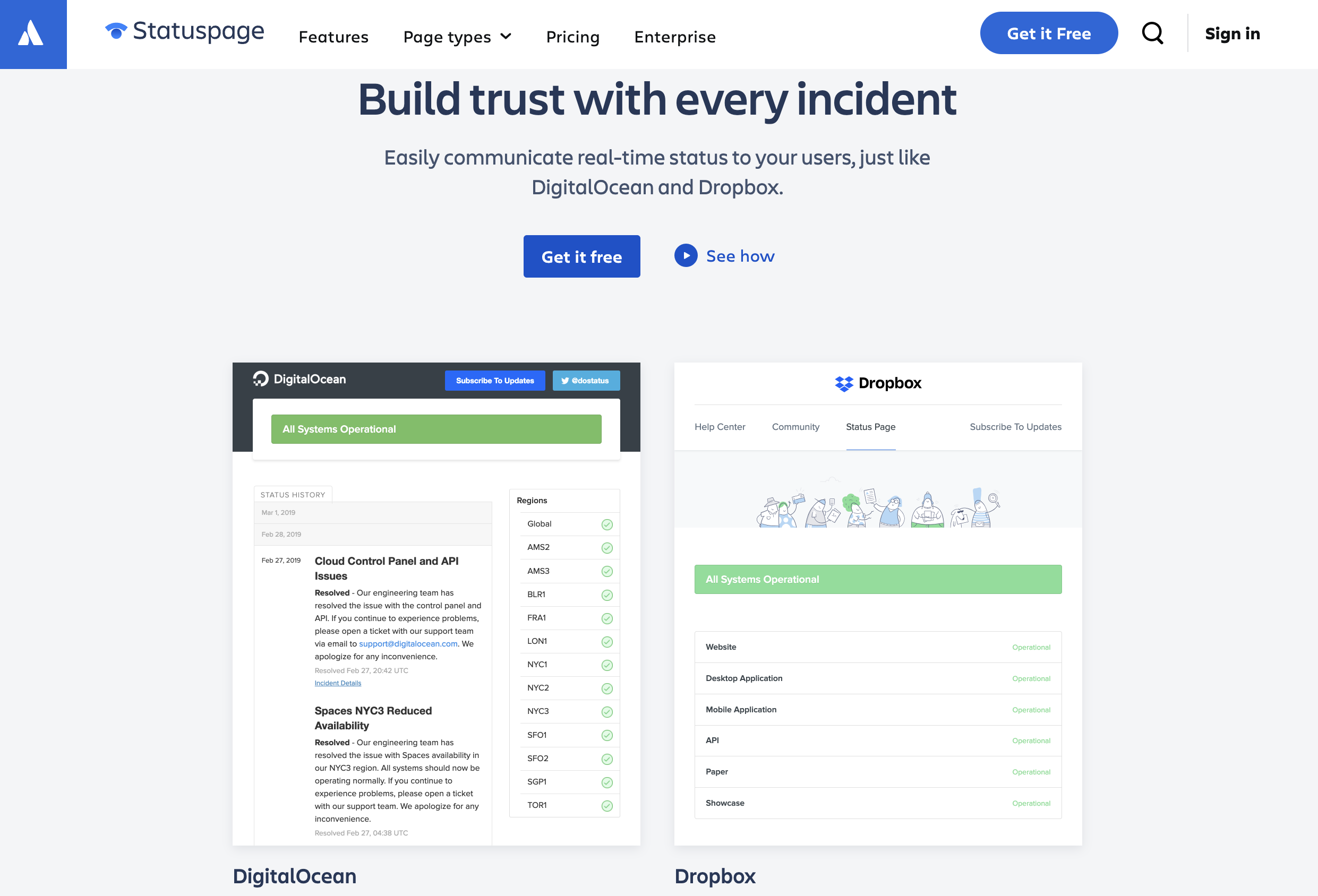
Statuspage.io, part of Atlassian, is one of the most established status page solutions in the market. While it offers comprehensive customization options and enterprise-grade features, its pricing structure can be prohibitive for smaller teams.
Pros
- Custom CSS/HTML/JS & extensive customization capabilities
Cons
- A single status page starts at $29/month but quickly goes to $99/month. Hyperping has unlimited pages (public and private) and a whole uptime monitoring suite for $74/month.
Why choose Hyperping over Statuspage.io?
More affordable scaling
Statuspage.io starts at $29/month for a single page and jumps to $99/month for basic features. Hyperping offers unlimited pages (public and private) plus comprehensive uptime monitoring for $74/month.
Simpler pricing model
While Statuspage.io charges separately for each page and locks features behind tiers, Hyperping includes all features and unlimited pages in a straightforward pricing structure.
Built-in monitoring integration
Statuspage.io requires separate monitoring solutions. Hyperping includes advanced monitoring capabilities out of the box, ensuring seamless status updates without additional integrations.
5. Uptime
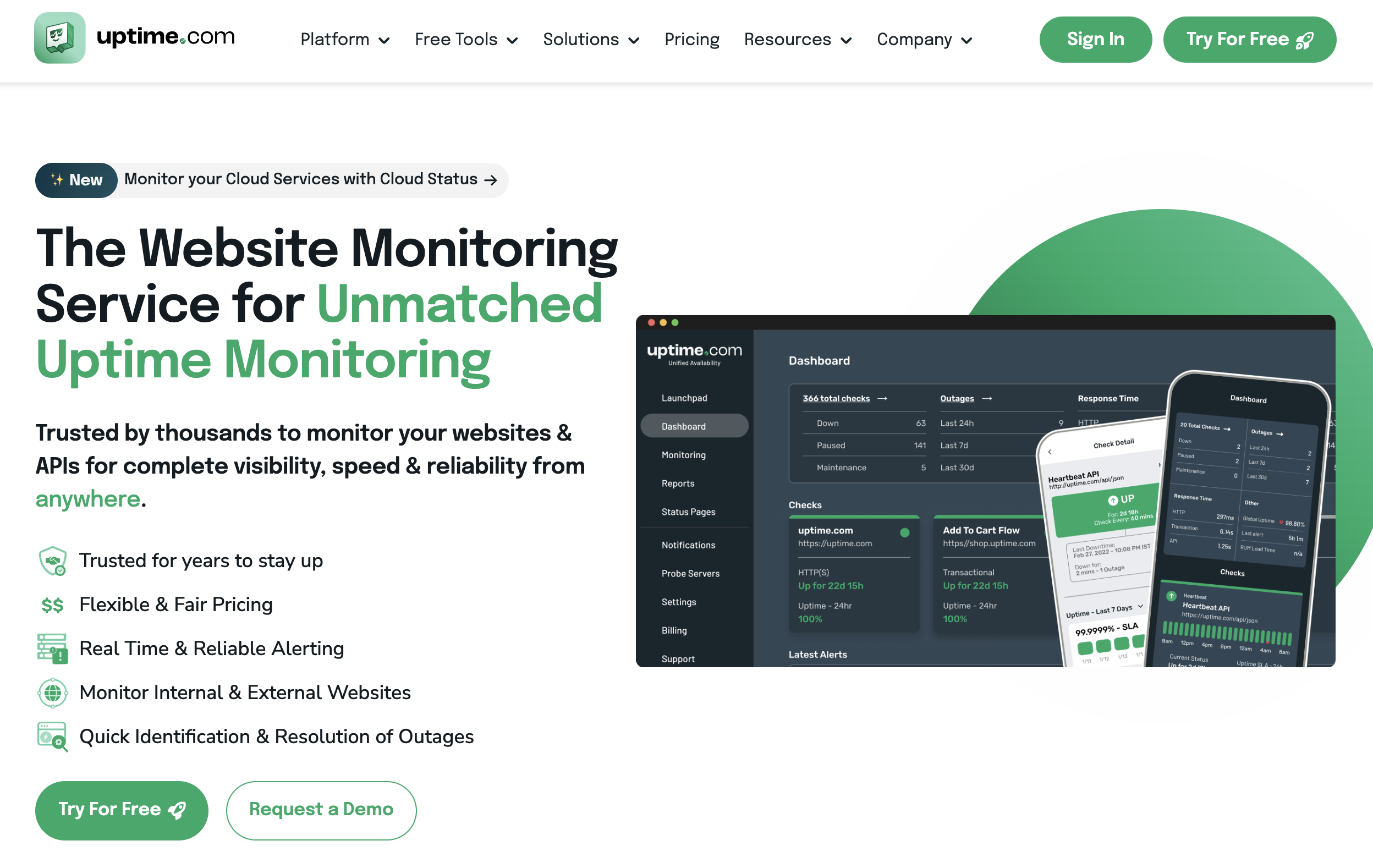
Uptime offers comprehensive monitoring capabilities with a focus on real user monitoring and synthetic testing. While it provides extensive global coverage, its restrictive check frequencies on lower-tier plans and complex visual editor for browser checks can limit its effectiveness.
Pros
- Plenty of check locations
- Large choice of monitors
- Real User Monitoring
Cons
- Long check frequency
- Visual browser checks
- Limited escalation policies
Why choose Hyperping over Uptime
30-second check frequency on all paid plans
Uptime limits the check frequency to a few minutes on their Starter and Essential plans. You need their premium $285/month plan to get to 1 minute checks. Hyperping has 30 second check frequency even on the smallest plan.
Access to all locations on all plans
While Uptime has more check locations worldwide than Hyperping, you have to pay for their $285/month plan to have access to all the locations. Hyperping doesn't have such limitation and allows you to use any location on all plans (even on the free plan).
Playwright for browser checks
Uptime uses a visual editor for browser checks. It's proprietary tech so you're locked in and have limited functionality. With Hyperping, synthetic monitors, you write code for browser checks. It uses Playwright, a popular Node.js library, among other libraries that will make writing advanced browser checks possible and easy.
Escalation policies
While Uptime does have a way to set up escalation rules, it has to be set up individually for each monitor you create. With Hyperping, you create policies you can then assign to monitors. So when you need to update these rules, it's effortless with Hyperping, and a hassle with Uptime.
Common mistakes when choosing status page software
Look, choosing status page software isn't complicated. But there are some common pitfalls that can lead to headaches down the road.
Let me walk you through the most frequent mistakes I see companies make, and more importantly, how to avoid them.
1. Not considering scalability
Here's the reality — your business will grow. And when it does, your status page needs to handle that growth smoothly.
How to avoid it:
- Choose platforms that offer unlimited components and metrics
- Look for solutions with flexible team management
- Make sure the pricing scales reasonably with your growth
2. Focusing only on price
Sure, budget matters. But picking the cheapest option often leads to missing crucial features you'll need later.
How to avoid it:
- Look at what you get for each pricing tier
- Think about the cost of switching platforms later
3. Ignoring integration capabilities
Your status page needs to work seamlessly with your existing tools. Otherwise, you're creating more manual work.
How to avoid it:
- Check compatibility with your monitoring tools — Better yet, use a solution that does monitoring AND status pages like Hyperping.
- Look for webhook support and API access
- Verify integration with notification systems
4. Overlooking customization needs
Every company has unique requirements. A one-size-fits-all approach rarely works well for status pages.
How to avoid it:
- Look for custom domain support
- Check branding and design flexibility
- Verify component grouping options
5. Not testing incident workflows
When an incident hits, you need smooth processes. Don't wait for a real crisis to discover workflow issues.
How to avoid it:
- Run through the incident creation process
- Test notification systems thoroughly
- Practice team collaboration features
- Verify subscriber management works as expected
6. Skipping performance checks
A slow or unreliable status page defeats its purpose. Performance matters, especially during high-traffic incidents.
How to avoid it:
- Check page load times
- Verify global availability
- Test mobile responsiveness
How to choose the right status page software
Still have a hard time making the decision? With so many options out there, each claiming to be the best, how do you make the right choice for your team?
The reality is, the "best" status page software depends entirely on your specific needs.
What works perfectly for a large enterprise might be overkill for a small startup. And what's ideal for a tech-savvy team might be too complex for others.
In this section, I'll walk you through exactly what you need to consider when choosing status page software, helping you make an informed decision that aligns with your team's requirements.
Essential features to consider
When evaluating status page solutions, certain features can make or break their effectiveness. Here are the key capabilities to look for:
- Automated incident detection — Monitor your services and create incidents automatically when issues arise
- Quick manual updates — Easy interface for posting updates during incidents
- Instant notification delivery — Ensure your users get alerts as soon as you post them
- Multiple notification channels — Email, SMS, Slack, and other integration options
- Maintenance scheduling — Tools for planning and communicating scheduled downtime
- Branding control — Match your status page to your company's look and feel
- Custom domains — Use your own domain for a seamless user experience
- Component flexibility — Freedom to structure your status page hierarchy
Business requirements
Your business context plays a crucial role in choosing the right solution. Consider these factors:
- Monthly costs — Including base fees and additional charges
- User pricing — How costs scale with team size
- Feature accessibility — Which features are included at different price points
- Subscriber limits — How many users can subscribe to updates
- Component restrictions — Maximum number of services you can monitor
- API access — Ability to automate and integrate as you grow
Technical specifications
Don't overlook the technical aspects that ensure reliable service:
- Page load speed — Status pages should load quickly, even under high traffic
- Global availability — Content delivery across different regions
- API flexibility — Robust API for custom integrations
- Webhook support — Automated actions based on status changes
How to implement status pages
Setting up a status page isn't just about picking a tool and turning it on.
It's about creating a reliable communication channel between your team and your users that builds trust and transparency.
To help you with this communication, we've created these resources:
- Read our guide on incident management
- Incident communication templates
- Create an internal status page
- Understanding SLA, SLO, and SLI
- Our proven escalation policy framework
Create a quick status page with Hyperping
Hyperping stands out among status page software for several reasons. Its all-in-one solution means you don't have to juggle multiple tools, simplifying your workflow. It offers built-in uptime monitoring, which is crucial for keeping your users informed in real-time about the status of your service. Check out how our customers' status pages look like to create reliable status pages.
The option to create static status pages ensures rapid loading times, enhancing the user experience. Hyperping also allows you to publish incident updates and schedule maintenance, keeping your users in the loop at all times.
What sets Hyperping apart is its integration capabilities. It seamlessly integrates with PagerDuty, Teams, Slack, and more, ensuring that your team stays coordinated and can respond promptly to any issues. It's also a great tool for multi-tenancy, making it a flexible solution for businesses of all sizes.
Choosing Hyperping as your status page provider not only gives you a powerful and intuitive tool, but also lets you benefit from a solution that is constantly evolving and improving to meet your needs.
Status page software FAQ
What is a status page software?
A status page provides information about the operational status of a software service or application to end users.
Status pages will typically display real-time (or near-real-time) information about the availability and performance of websites or different software programs and any ongoing incidents or outages they may be experiencing.
Why are status pages important?
Honestly, there are a million reasons to have a status page nowadays. But here are some of the most compelling:
They put you in control
A good status page will enhance your software monitoring and reporting processes.
The right tool for managing uptime performance should provide you with a broad range of features, including incident insights & management, notifications and alerts, SSL monitoring, and customizable HTTP requests to give you total control of uptime performance.
They help manage customer expectations
Providing customers with complete transparency into issues and responses by using a status page helps an organization build trust with its end-users.
It gives the user greater autonomy in the business/client relationship by empowering them to identify and determine their response to any given situation. It also raises their perception of the business by being forthcoming and honest about issues that could or will impact the end user.
They reduce lost revenue
Roughly 43% of businesses report a loss of data following an outage. What happens if the data you lose is critical—say, all of your customer information? Just how costly might that sort of incident be for your business?
Software and application monitoring and reporting tools prevent these sorts of catastrophic incidents from occurring in the first place by arming you with the tools needed to fix errors or pre-empt their impact on users in real-time.


